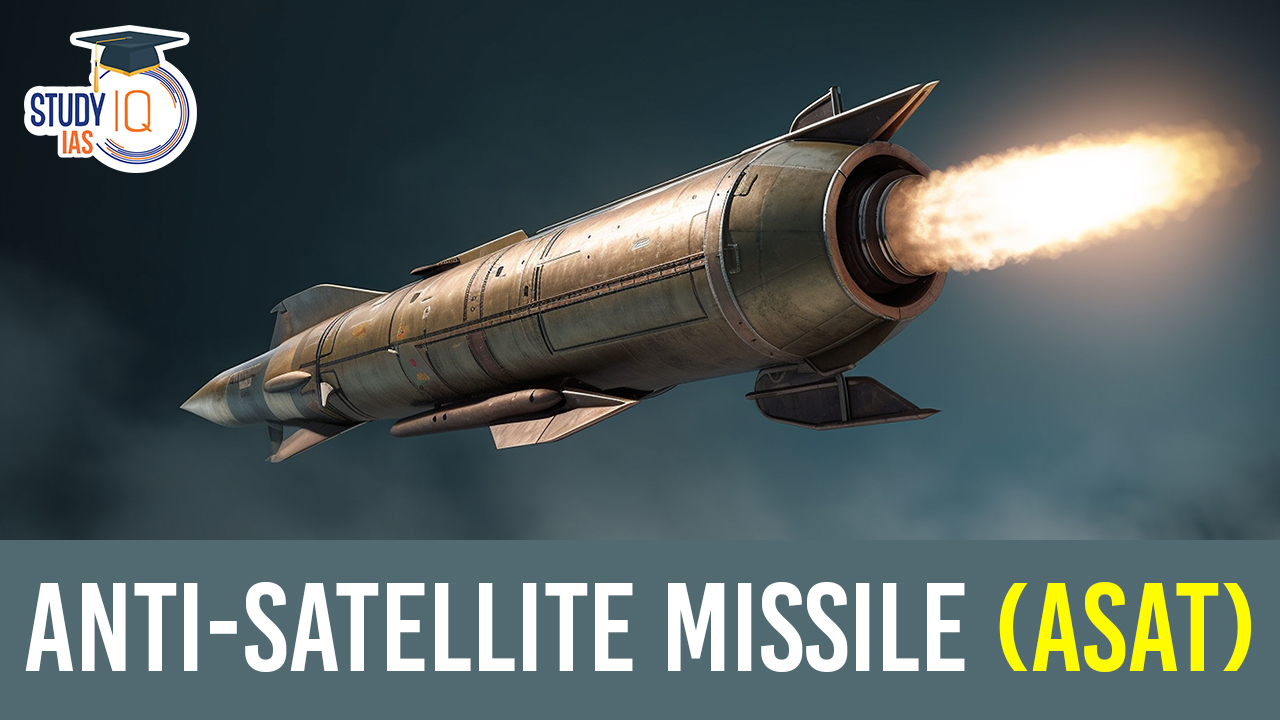Table of Contents
An Anti-Satellite Missile (ASAT) is a type of missile designed to destroy or disable satellites in space. These missiles are typically used as a military capability to counter potential threats posed by enemy satellites, or to protect a nation’s own satellites in the event of a conflict. ASAT missiles are part of the broader category of anti-satellite weapons (ASAT weapons).
Anti-satellite weapons (ASAT)
Anti-satellite weapons (ASAT) are designed to disable or destroy satellites for various purposes, such as defense against an adversary’s space-based weapons, nuclear first strikes, countering anti-ballistic missile defenses, and more. While not used in actual warfare, countries like China, India, Russia, and the United States have demonstrated their ASAT capabilities by shooting down their own satellites. However, this activity creates space debris that poses a significant risk, potentially leading to the Kessler syndrome, a chain reaction of collisions among space debris with detrimental consequences for Earth’s orbit.
We’re now on WhatsApp. Click to Join
Anti-satellite weapons (ASAT) History
In 1957, the Soviet Union’s launch of Sputnik 1 prompted US concerns about the potential development of a nuclear-armed satellite network by their Cold War rivals. The US responded by creating its first Anti-Satellite Missile (ASAT), Bold Orion, which was an air-launched ballistic missile. In turn, the Soviets developed co-orbital ASATs, satellites that flew alongside targets and self-destructed to disable them. China joined the ASAT race in 2007 by destroying a weather satellite with a ballistic missile, contributing to a perilous increase in space debris. In April 2022, the US took a significant step by announcing a ban on missile use against satellites, addressing space security concerns.
Types of Anti-Satellite Missiles (ASATs)
Anti-Satellite Missiles (ASATs) come in various types and can be categorized based on their methods of operation. The main types of ASATs are:
Kinetic Energy ASATs
These missiles physically collide with the target satellite, using their high speed and kinetic energy to destroy or disable the satellite upon impact. They can be launched from a variety of platforms, including ground-based launchers, aircraft, or other satellites.
Non-Kinetic ASATs
Non-kinetic ASATs use non-physical methods to incapacitate or destroy satellites. These methods include:
- Cyber-Attacks: ASATs can launch cyber-attacks to disrupt the target satellite’s communication, navigation, or control systems.
- Jamming: ASATs may emit radio frequency signals to jam or interfere with the satellite’s transmissions, rendering it ineffective.
- Laser Blinding: High-energy lasers can be used to blind or damage the optical sensors or solar panels of a satellite.
Anti Satellite Missile of India
India’s first anti-satellite (ASAT) missile test was called Mission Shakti. The test was conducted on March 27, 2019. The ASAT system was developed by the Defence Research and Development Organisation (DRDO) and the Indian Space Research Organisation (ISRO). The test was executed on Dr A P J Abdul Kalam Island, formerly known as Wheeler Island, an island off the coast of Odisha.
Mission Shakti
| Fact | Details |
| Mission Name | Mission Shakti |
| India’s Status | Fourth country to successfully conduct an Anti-Satellite Missile (ASAT) test |
| Target Satellite | An existing Indian satellite in Earth’s lower orbit |
| Satellite’s Status | Still operational but had outlived its utility |
| Satellite’s Altitude | Approximately 300 km from Earth |
| NOTAM Notice | Sent to airline authorities of different countries to alert them about the missile test |
| NOTAM Definition | Notice to Airmen (NOTAM) contains information about potential flight hazards and safety concerns |
| Space Debris | No significant space debris generated; the test was conducted in Earth’s lower atmosphere |
| Debris Disposition | Debris fell back to Earth within weeks |
| Missile Used | Ballistic Missile Defence interceptor of DRDO, part of India’s ballistic missile defence program |
| Mission Purpose | Demonstrated India’s commitment to enhancing national security and advancing space development |
Concerns with Anti-Satellite (ASAT)
- Space Debris: ASAT tests create space debris, posing collision risks.
- Militarization: Weapons in space can trigger an arms race.
- Strategic Instability: ASATs can escalate tensions and conflict fears.
- Civilian Impact: Disruptions affect commercial and scientific space activities.
- Environmental Risks: Space debris endangers the environment and Earth.
- International Agreements: ASAT actions challenge space treaties.
- Deterrence and Conflict: ASATs act as deterrence but can provoke conflict.
- Transparency Issues: Secrecy fuels suspicions, requiring international cooperation for solutions.
Anti-Satellite Missiles (ASATs) UPSC
Anti-Satellite Missiles (ASATs) are space weapons designed to destroy or disable satellites, posing concerns about space debris, militarization, and strategic instability. ASAT capabilities have been demonstrated by countries like China, India, Russia, and the United States. History reveals the development of ASATs during the Cold War, leading to the creation of kinetic and non-kinetic ASATs. India conducted its first successful ASAT test, Mission Shakti, in 2019, showcasing its national security goals. Despite these achievements, there is international unease about space weaponization and calls for transparency and cooperation to address the associated challenges.


 AI and its Regulation in India, Limitati...
AI and its Regulation in India, Limitati...
 Tuberculosis (TB), Symptoms, Causes and ...
Tuberculosis (TB), Symptoms, Causes and ...
 Silicon Photonics Enables Low-power AI A...
Silicon Photonics Enables Low-power AI A...





















